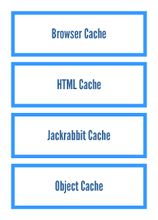About caching
Caches
Caches enable high performing web systems such as Jahia to avoid recreating dynamic content under large system loads. Jahia uses a multi-layered caching subsystem.
Cache types
Cache types use the same cache service that is responsible for providing cache implementations. Jahia now standardizes on the EHCache implementation, which can range from very simple setups all the way to distributed TerraCotta or BigMemory cache instances.
Jahia uses multiple cache layers to optimize the performance of page delivery, including:
- The browser cache
- Front-end HTML caches
- Object caches
- Database caches
Each of these cache layers plays a different role in making sure values are only computed once.
The browser cache layer
While integrated in the browser rather than Jahia, the browser cache plays a critical role in guaranteeing good performance for the end-user. For example, Jahia's usage of the GWT framework makes it possible for AJAX source code to be aggressively cached in the browser cache. This ensures that unchanged script code is not reloaded. Jahia also properly manages the browser cache to make sure it doesn't cache page content that has changed. Jahia also controls expiration times for cached content so that the browser doesn't request content that is rarely changed.
The front-end HTML cache layer
Jahia combines the efficiency of embedded full-page caching with the fragment handling of the ESI cache server. This cache implementation, the Module Cache, integrates fragment caching at a module level, making the interaction with templates very natural. Template developers usually don't have to add markup to have their fragments correctly cached. Even when they need to control fragment generation, this is much easier to do than in previous versions of Jahia. The Skeleton Cache is also an HTML front-end cache that basically caches everything "around" the fragments, and by regrouping both cache sub-systems Jahia obtains the equivalent in terms of performance to the full-page HTML cache that existed in previous versions of Jahia while retaining the flexibility of a fragment cache.
Object cache layer
The object cache layer is the next layer below the front-end HTML cache sub-systems. This layer handles some Java objects that cannot be optimally cached by the underlying layers. In previous versions of Jahia, this layer had a lot of different caches, but in the most recent versions it has been reduced to the strict minimum based on performance testing. It serves as a layer on top of the database caches in order to avoid reconstructing objects for each model request. This is all handled internally by Jahia and it is only important to interact with these caches if integrators are directly calling back-end APIs that don't automatically update the caches. A good example of this is the LDAP user and group caches.
Database caches
The database cache layer makes sure that only minimal interaction with the database happens. This cache is important because database communication requires object (de-)serialization as well as network communication, so the overhead of database query execution may be quite substantial. The Hibernate ORM and Jackrabbit frameworks handle this layer transparently, so normally developers and integrators will not need to deal with it.
